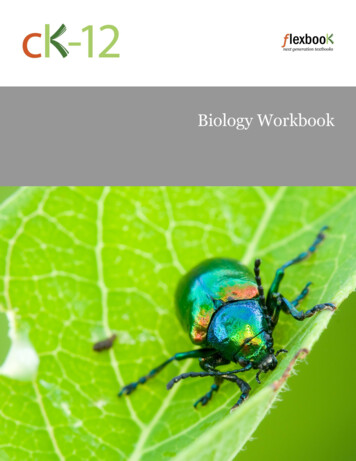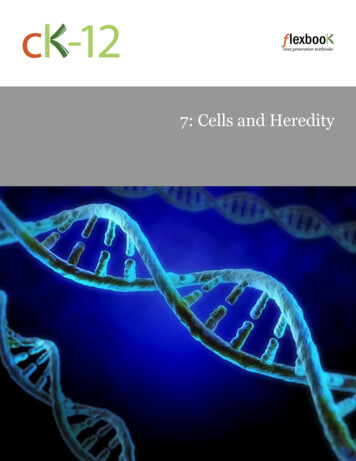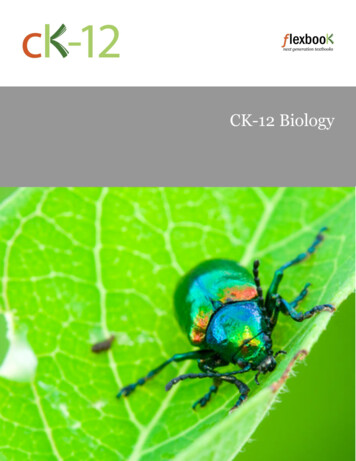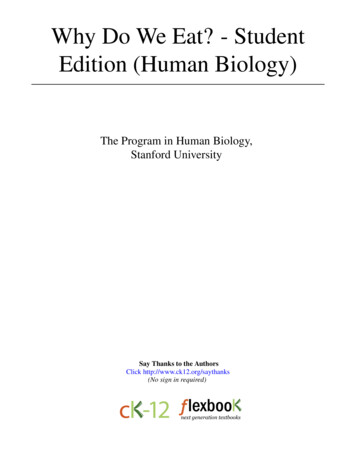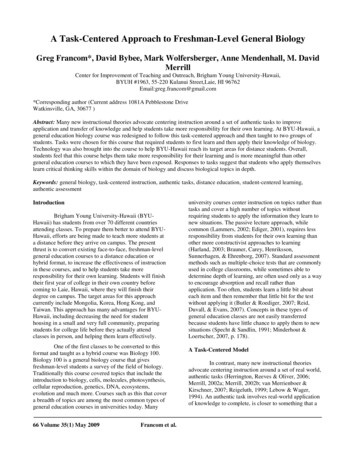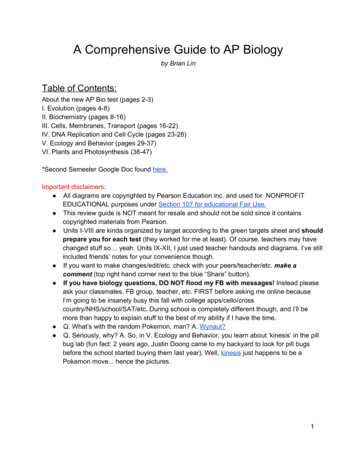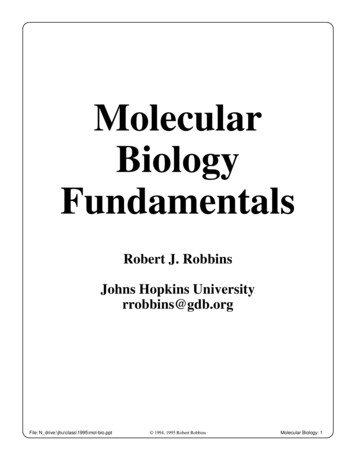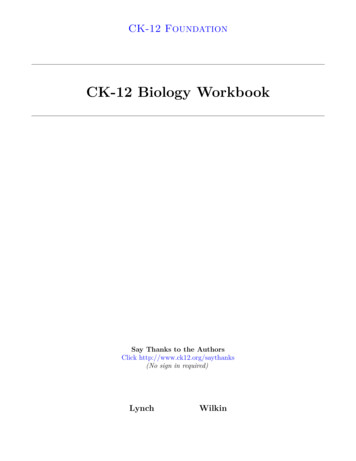
Transcription
CK-12 FOUNDATIONCK-12 Biology WorkbookSay Thanks to the AuthorsClick http://www.ck12.org/saythanks(No sign in required)LynchWilkin
To access a customizable version of this book, as well as other interactive content, visit www.ck12.orgCK-12 Foundation is a non-profit organization with a mission to reduce the cost of textbook materials for the K-12 market both in the U.S. and worldwide. Using an open-content, web-based collaborativemodel termed the FlexBook , CK-12 intends to pioneer the generation and distribution of high-qualityeducational content that will serve both as core text as well as provide an adaptive environment forlearning, powered through the FlexBook Platform .Copyright 2011 CK-12 Foundation, www.ck12.orgThe names “CK-12” and “CK12” and associated logos and the terms “FlexBook ,” and “FlexBookPlatform ,” (collectively “CK-12 Marks”) are trademarks and service marks of CK-12 Foundation andare protected by federal, state, and international laws.Any form of reproduction of this book in any format or medium, in whole or in sections must include thereferral attribution link http://www.ck12.org/saythanks (placed in a visible location) in addition tothe following terms.Except as otherwise noted, all CK-12 Content (including CK-12 Curriculum Material) is made available toUsers in accordance with the Creative Commons Attribution/Non-Commercial/Share Alike 3.0 Unported(CC-BY-NC-SA) License ), as amended andupdated by Creative Commons from time to time (the “CC License”), which is incorporated herein by thisreference.Complete terms can be found at http://www.ck12.org/terms.Printed: May 7, 2012
AuthorsMargaret Lynch, Douglas WilkinContributorDoris KrausEditorDouglas Wilkiniwww.ck12.org
Contents1 What is Biology? Worksheets11.1Science and the Natural World . . . . . . . . . . . . . . . . . . . . . . . . . . . . . . . . . .21.2Biology: The Study of Life9. . . . . . . . . . . . . . . . . . . . . . . . . . . . . . . . . . . .2 The Chemistry of LifeWorksheets162.1Matter and Organic Compounds . . . . . . . . . . . . . . . . . . . . . . . . . . . . . . . . .172.2Biochemical Reactions . . . . . . . . . . . . . . . . . . . . . . . . . . . . . . . . . . . . . . .242.3Water, Acids, and Bases . . . . . . . . . . . . . . . . . . . . . . . . . . . . . . . . . . . . . .313 Cellular Structure andFunction Worksheets393.1Introduction to Cells . . . . . . . . . . . . . . . . . . . . . . . . . . . . . . . . . . . . . . . .403.2Cell Structures . . . . . . . . . . . . . . . . . . . . . . . . . . . . . . . . . . . . . . . . . . .473.3Cell Transport and Homeostasis . . . . . . . . . . . . . . . . . . . . . . . . . . . . . . . . . .554 Photosynthesis and CellularRespiration Worksheets634.1Energy for Life . . . . . . . . . . . . . . . . . . . . . . . . . . . . . . . . . . . . . . . . . . .644.2Photosynthesis: Sugar as Food . . . . . . . . . . . . . . . . . . . . . . . . . . . . . . . . . .724.3Powering the Cell: Cellular Respiration . . . . . . . . . . . . . . . . . . . . . . . . . . . . .804.4Anaerobic Respiration . . . . . . . . . . . . . . . . . . . . . . . . . . . . . . . . . . . . . . .885 The Cell Cycle, Mitosis, andMeiosis Worksheets965.1Cell Division and the Cell Cycle. . . . . . . . . . . . . . . . . . . . . . . . . . . . . . . . .5.2Chromosomes and Mitosis . . . . . . . . . . . . . . . . . . . . . . . . . . . . . . . . . . . . . 1045.3Reproduction and Meiosis . . . . . . . . . . . . . . . . . . . . . . . . . . . . . . . . . . . . . 1126 Gregor Mendel and GeneticsWorksheetswww.ck12.org97120ii
6.1Mendel’s Investigations. . . . . . . . . . . . . . . . . . . . . . . . . . . . . . . . . . . . . . 1216.2Mendelian Inheritance . . . . . . . . . . . . . . . . . . . . . . . . . . . . . . . . . . . . . . . 1297 Molecular Genetics: From DNAto Proteins Worksheets1377.1DNA and RNA . . . . . . . . . . . . . . . . . . . . . . . . . . . . . . . . . . . . . . . . . . . 1387.2Protein Synthesis . . . . . . . . . . . . . . . . . . . . . . . . . . . . . . . . . . . . . . . . . . 1467.3Mutation . . . . . . . . . . . . . . . . . . . . . . . . . . . . . . . . . . . . . . . . . . . . . . 1547.4Regulation of Gene Expression . . . . . . . . . . . . . . . . . . . . . . . . . . . . . . . . . . 1618 Human Genetics andBiotechnology Worksheets1698.1Human Chromosomes and Genes . . . . . . . . . . . . . . . . . . . . . . . . . . . . . . . . . 1708.2Human Inheritance . . . . . . . . . . . . . . . . . . . . . . . . . . . . . . . . . . . . . . . . . 1788.3Biotechnology . . . . . . . . . . . . . . . . . . . . . . . . . . . . . . . . . . . . . . . . . . . . 1869 Life: From the First OrganismOnward Worksheets1949.1Earth Forms and Life Begins . . . . . . . . . . . . . . . . . . . . . . . . . . . . . . . . . . . 1959.2The Evolution of Multicellular Life . . . . . . . . . . . . . . . . . . . . . . . . . . . . . . . . 2039.3Classification . . . . . . . . . . . . . . . . . . . . . . . . . . . . . . . . . . . . . . . . . . . . 21110 The Theory of EvolutionWorksheets21810.1 Darwin and the Theory of Evolution . . . . . . . . . . . . . . . . . . . . . . . . . . . . . . . 21910.2 Evidence for Evolution . . . . . . . . . . . . . . . . . . . . . . . . . . . . . . . . . . . . . . . 22610.3 Microevolution and the Genetics of Populations . . . . . . . . . . . . . . . . . . . . . . . . . 23410.4 Macroevolution and the Origin of Species . . . . . . . . . . . . . . . . . . . . . . . . . . . . 24211 The Principles of EcologyWorksheets25011.1 The Science of Ecology . . . . . . . . . . . . . . . . . . . . . . . . . . . . . . . . . . . . . . . 25111.2 Recycling Matter . . . . . . . . . . . . . . . . . . . . . . . . . . . . . . . . . . . . . . . . . . 25811.3 Biomes . . . . . . . . . . . . . . . . . . . . . . . . . . . . . . . . . . . . . . . . . . . . . . . . 26512 Communities and PopulationsWorksheets27312.1 Community Interactions . . . . . . . . . . . . . . . . . . . . . . . . . . . . . . . . . . . . . . 27412.2 Characteristics of Population . . . . . . . . . . . . . . . . . . . . . . . . . . . . . . . . . . . 28112.3 Human Population Growth . . . . . . . . . . . . . . . . . . . . . . . . . . . . . . . . . . . . 28912.4 The Biodiversity Crisis . . . . . . . . . . . . . . . . . . . . . . . . . . . . . . . . . . . . . . . 296iiiwww.ck12.org
12.5 Natural Resources and Climate Change . . . . . . . . . . . . . . . . . . . . . . . . . . . . . 30313 Microorganisms: Prokaryotesand Viruses Worksheets31013.1 Prokaryotes . . . . . . . . . . . . . . . . . . . . . . . . . . . . . . . . . . . . . . . . . . . . . 31113.2 Viruses. . . . . . . . . . . . . . . . . . . . . . . . . . . . . . . . . . . . . . . . . . . . . . . 31814 Eukaryotes: Protists andFungi Worksheets32614.1 Introduction to Protists . . . . . . . . . . . . . . . . . . . . . . . . . . . . . . . . . . . . . . 32714.2 Types of Protists . . . . . . . . . . . . . . . . . . . . . . . . . . . . . . . . . . . . . . . . . . 33514.3 Introduction to Fungi . . . . . . . . . . . . . . . . . . . . . . . . . . . . . . . . . . . . . . . 34214.4 Ecology of Fungi . . . . . . . . . . . . . . . . . . . . . . . . . . . . . . . . . . . . . . . . . . 35014.5 Protists, Fungi, and Human Disease . . . . . . . . . . . . . . . . . . . . . . . . . . . . . . . 35715 Plant Evolution andClassification Worksheets36415.1 Introduction to the Plant Kingdom . . . . . . . . . . . . . . . . . . . . . . . . . . . . . . . . 36515.2 Four Types of Modern Plants . . . . . . . . . . . . . . . . . . . . . . . . . . . . . . . . . . . 37315.3 Plant Evolution and Classification . . . . . . . . . . . . . . . . . . . . . . . . . . . . . . . . 38016 Plant Biology Worksheets38416.1 Plant Tissues and Growth . . . . . . . . . . . . . . . . . . . . . . . . . . . . . . . . . . . . . 38516.2 Plant Organs: Roots, Stems, and Leaves . . . . . . . . . . . . . . . . . . . . . . . . . . . . . 39216.3 Variation in Plant Life Cycles . . . . . . . . . . . . . . . . . . . . . . . . . . . . . . . . . . . 40016.4 Plant Adaptations and Responses . . . . . . . . . . . . . . . . . . . . . . . . . . . . . . . . . 40717 Introduction to AnimalsWorksheets41317.1 Overview of Animals . . . . . . . . . . . . . . . . . . . . . . . . . . . . . . . . . . . . . . . . 41417.2 Overview of Invertebrates . . . . . . . . . . . . . . . . . . . . . . . . . . . . . . . . . . . . . 42218 From Sponges to InvertebrateChordates Worksheets42918.1 Sponges, Cnidarians, Flatworms, and Roundworms . . . . . . . . . . . . . . . . . . . . . . . 43018.2 Mollusks and Annelids . . . . . . . . . . . . . . . . . . . . . . . . . . . . . . . . . . . . . . . 43818.3 Arthropods and Insects . . . . . . . . . . . . . . . . . . . . . . . . . . . . . . . . . . . . . . 44418.4 Echinoderms and Invertebrate Chordates . . . . . . . . . . . . . . . . . . . . . . . . . . . . 45219 From Fish to Birds Worksheets46019.1 Overview of Vertebrates . . . . . . . . . . . . . . . . . . . . . . . . . . . . . . . . . . . . . . 461www.ck12.orgiv
19.2 Fish . . . . . . . . . . . . . . . . . . . . . . . . . . . . . . . . . . . . . . . . . . . . . . . . . 46919.3 Amphibians . . . . . . . . . . . . . . . . . . . . . . . . . . . . . . . . . . . . . . . . . . . . . 47619.4 Reptiles . . . . . . . . . . . . . . . . . . . . . . . . . . . . . . . . . . . . . . . . . . . . . . . 48419.5 Birds . . . . . . . . . . . . . . . . . . . . . . . . . . . . . . . . . . . . . . . . . . . . . . . . . 49220 Mammals and Animal BehaviorWorksheets50020.1 Mammalian Traits . . . . . . . . . . . . . . . . . . . . . . . . . . . . . . . . . . . . . . . . . 50120.2 Reproduction in Mammals . . . . . . . . . . . . . . . . . . . . . . . . . . . . . . . . . . . . . 50920.3 Evolution and Classification of Mammals . . . . . . . . . . . . . . . . . . . . . . . . . . . . 51720.4 Overview of Animal Behavior . . . . . . . . . . . . . . . . . . . . . . . . . . . . . . . . . . . 52521 Introduction to the HumanBody: Bones, Muscles, andSkin Worksheets53221.1 Organization of the Human Body . . . . . . . . . . . . . . . . . . . . . . . . . . . . . . . . . 53321.2 The Skeletal System . . . . . . . . . . . . . . . . . . . . . . . . . . . . . . . . . . . . . . . . 54121.3 The Muscular System . . . . . . . . . . . . . . . . . . . . . . . . . . . . . . . . . . . . . . . 54821.4 The Integumentary System . . . . . . . . . . . . . . . . . . . . . . . . . . . . . . . . . . . . 55522 The Nervous and EndocrineSystems Worksheets56122.1 The Nervous System . . . . . . . . . . . . . . . . . . . . . . . . . . . . . . . . . . . . . . . . 56222.2 The Endocrine System . . . . . . . . . . . . . . . . . . . . . . . . . . . . . . . . . . . . . . . 57123 The Circulatory, Respiratory,Digestive, and ExcretorySystems Worksheets57923.1 The Circulatory System . . . . . . . . . . . . . . . . . . . . . . . . . . . . . . . . . . . . . . 58023.2 The Respiratory System . . . . . . . . . . . . . . . . . . . . . . . . . . . . . . . . . . . . . . 58823.3 The Digestive System . . . . . . . . . . . . . . . . . . . . . . . . . . . . . . . . . . . . . . . 59623.4 The Excretory System . . . . . . . . . . . . . . . . . . . . . . . . . . . . . . . . . . . . . . . 60424 The Immune System and DiseaseWorksheets61124.1 Nonspecific Defenses . . . . . . . . . . . . . . . . . . . . . . . . . . . . . . . . . . . . . . . . 61224.2 The Immune Response . . . . . . . . . . . . . . . . . . . . . . . . . . . . . . . . . . . . . . . 62024.3 Immune System Diseases . . . . . . . . . . . . . . . . . . . . . . . . . . . . . . . . . . . . . . 62824.4 Environmental Problems and Human Health . . . . . . . . . . . . . . . . . . . . . . . . . . 63625 Reproduction and Humanvwww.ck12.org
Development Worksheets25.1 Male Reproductive System643. . . . . . . . . . . . . . . . . . . . . . . . . . . . . . . . . . . . 64425.2 Female Reproductive System . . . . . . . . . . . . . . . . . . . . . . . . . . . . . . . . . . . 65225.3 From Fertilization to Old Age . . . . . . . . . . . . . . . . . . . . . . . . . . . . . . . . . . . 66025.4 Sexually Transmitted Infections . . . . . . . . . . . . . . . . . . . . . . . . . . . . . . . . . . 668www.ck12.orgvi
Chapter 1What is Biology? Worksheets(Opening image copyright by Kirsty Pargeter, 2010. Used under license from Shutterstock.com.) Lesson 1.1: Science and the Natural World Lesson 1.2: Biology: The Study of Life1www.ck12.org
1.1Science and the Natural WorldLesson 1.1: True or FalseName Class DateWrite true if the statement is true or false if the statement is false.1. A hypothesis must be based on scientific knowledge.2. A scientific theory is a guess about how or why something happens.3. Scientists make predictions that tell what will happen under any and all conditions.4. The scientific method includes the steps involved in a scientific investigation.5. “Did life on Earth evolve over time?” This question can be answered scientifically.6. Experiments are performed under controlled conditions.7. Scientists can study all aspects of the natural world, including experimenting on an extinctanimal.8. The dependent variable is always the opposite of the independent variable.9. Communicating your results allows others to test your hypothesis.10. Experimental evidence that agrees with your prediction supports your hypothesis.11. The first step in a scientific investigation is always to develop a hypothesis.12. Scientists gradually build an increasingly accurate and detailed understanding of the naturalworld.13. Newton discovered the law of gravity when an apple fell from a tree and hit him on the head.14. Scientific evidence is any type of data that may either agree or disagree with a prediction.15. Scientific theories are broad explanations that are widely accepted as true.www.ck12.org2
Lesson 1.1: Critical ReadingName Class DateRead these passages from the text and answer the questions that follow.Nature Can Be UnderstoodScientists think of nature as a single system controlled by natural laws. By discovering natural laws,scientists strive to increase their understanding of the natural world. Laws of nature are expressed asscientific laws. A scientific law is a statement that describes what always happens under certain conditionsin nature.An example of a scientific law is the law of gravity, which was discovered by Sir Isaac Newton. The lawof gravity states that objects always fall towards Earth because of the pull of gravity. Based on this law,Newton could explain many natural events. He could explain not only why objects such as apples alwaysfall to the ground, but he could also explain why the moon orbits Earth. Isaac Newton discovered laws ofmotion as well as the law of gravity. His laws of motion allowed him to explain why objects move as theydo.Science Cannot Answer All QuestionsScience rests on evidence and logic, so it deals only with things that can be observed. An observationis anything that is detected either through human senses or with instruments and measuring devicesthat extend human senses. Things that cannot be observed or measured by current means — such assupernatural beings or events — are outside the bounds of science. Consider these two questions aboutlife on Earth: Did life on Earth evolve over time? Was life on Earth created through another method?The first question can be answered by science on the basis of scientific evidence and logic. The secondquestion could be a matter of belief. Therefore, it is outside the realm of science.Questions1. What is an observation?2. What is a scientific law?3. What scientific law explains why the moon orbits the Earth? What does the law state? Who developedthis law?4. Complete this sentence: Natural laws allow scientists to .3www.ck12.org
5. Can science answer all questions? Justify your answer.www.ck12.org4
Lesson 1.1: Multiple ChoiceName Class DateCircle the letter of the correct choice.1. Assumptions scientists make include:(a)(b)(c)(d)Nature can be understood through systematic study.Scientific ideas never need to be revised.Science can provide answers to all questions.all of the above2. A hypothesis(a)(b)(c)(d)is the first step in a scientific investigation.is based on what a scientist believes.is a possible question to a scientific answer.can be proved incorrect.3. A scientific theory(a)(b)(c)(d)is based on lots of evidence.is a guess about how or why something happens.can never be altered or changed.none of the above4. Which is the correct order in a scientific investigation?(a)(b)(c)(d)ask a question, test the hypothesis, communicate results, draw conclusionsmake observations, ask a question, form a hypothesis, test the hypothesisdraw conclusions, ask a question, form a hypothesis, test the hypothesisask a question, make observations, test the hypothesis, draw conclusions5. To test a tistscientistfirstfirstfirstfirstcollects evidence.draws conclusions.makes a prediction.makes observations.6. An experiment(a)(b)(c)(d)is performed under controlled conditions.generally tests how one variable is affected by another.contributes important evidence that helps scientists better understand the natural world.all of the above7. Food chains are scientific models that(a)(b)(c)(d)represent simple systems in nature.make the scientific systems easier to understand.are based on mathematical equations.are based on a prediction.8. Science cannot answer all ue because science cannot answer matters of belief.true because all science is based on logic.false because science can prove that life evolves over time.false because science is based on observations and evidence.5www.ck12.org
Lesson 1.1: Vocabulary IName Class DateMatch the vocabulary word with the proper definition.Definitions1. a statement that describes what always happens under certain conditions in nature2. a possible answer to a scientific question3. any type of data that may either agree or disagree with a prediction4. a plan for asking questions and testing possible answers5. a representation of part of the real world6. a broad explanation for events that is widely accepted as true7. detected either through human senses or with instruments and measuring devices that extendhuman senses8. a special type of scientific investigation that is performed under controlled conditions9. developed the laws of motion10. a statement that tells what will happen under certain conditions11. developed theory of relativity12. a distinctive way of gaining knowledge about the natural worldTermsa. Albert Einsteinb. evidencec. experimentd. hypothesise. Isaac Newtonf. modelg. observationh. predictioni. sciencej. scientific investigationk. scientific lawl. scientific theorywww.ck12.org6
Lesson 1.1: Vocabulary IIName Class DateFill in the blank with the appropriate term.1. An is anything that is detected either through human senses or with instrumentsand measuring devices that extend human senses.2. An is a special type of scientific investigation that is performed under controlledconditions.3. A scientific is a statement that describes what always happens under certainconditions in nature.4. A model is a representation of part of the real .5. is any type of data that may either agree or disagree with a prediction.6. Scientific investigation are done by following the scientific .7. The goal of is to understand the natural world.8. A hypothesis is a possible answer to a scientific .9. Matters of are outside the realm of science.10. A scientific is a broad explanation for events that is widely accepted as true.11. The last step in a scientific investigation is what you have learned with others.12. is a distinctive way of gaining knowledge about the natural world that starts witha question and then tries to answer the question with evidence and logic7www.ck12.org
Lesson 1.1: Critical WritingName Class DateThoroughly answer the question below. Use appropriate academic vocabulary and clear and completesentences.Discuss why science is not able to answer all questions. Incorporate the steps of the scientific method intoyour response.www.ck12.org8
1.2Biology: The Study of LifeLesson 1.2: True or FalseName Class DateWrite true if the statement is true or false if the statement is false.1. A cell is the basic unit of the structure and function of all living things2. An adaptation is a characteristic that helps a living thing survive and reproduce.3. Natural selection is a change in the characteristics of living things over time.4. A population consists of many different species.5. Charles Darwin developed the theory of evolution by natural selection.6. All living things must maintain homeostasis.7. The characteristics of all living things are controlled by genes.8. The four unifying principles of biology are the cell theory, the gene theory, homeostasis, andgravity.9. Deer sometimes eat the starlings (birds) that sit on them.10. The cells of many different organisms are very similar.11. Simple life forms, like bacteria, have simple chemistry.12. Simple life forms, like bacteria, do not grow and develop.13. Every living thing begins life as a single cell.14. The mole’s touch organ is an adaptation because it helps the mole survive in its dark.15. There are at least 100 million different species live on Earth today.9www.ck12.org
Lesson 1.2: Critical ReadingName Class DateRead this passage from the text and answer the questions that follow.Evolution of LifeThe diversity of life on Earth today is the result of evolution. Life began on Earth at least 4 billionyears ago, and it has been evolving ever since. At first, all living things on Earth were simple, singlecelled organisms. Much later, the first multicellular organisms evolved, and after that, Earth’s biodiversitygreatly increased.Today, scientists accept the evolution of life on Earth as a fact. There is too much evidence supportingevolution to doubt it. However, that wasn’t always the case.Darwin and the Theory of EvolutionThe idea of evolution has been around for centuries. In fact, it goes all the way back to the ancient Greekphilosopher Aristotle. However, evolution is most often associated with Charles Darwin. Darwin publisheda book on evolution in 1869 titled On the Origin of Species. In the book, Darwin stated the theory ofevolution by natural selection. He also presented a great deal of evidence that evolution occurs. Despiteall the evidence Darwin presented, his theory was not well received at first. Many people found it hard toaccept the idea that humans had evolved from an ape-like ancestor, and they saw evolution as a challengeto their religious beliefs. Darwin had actually expected this type of reaction to his theory and had waiteda long time before publishing his book for this reason. It was only when another scientist, named AlfredWallace, developed essentially the same theory of evolution that Darwin put his book into print.Although Darwin presented a great deal of evidence for evolution in his book, he was unable to explainhow evolution occurs. That’s because he knew nothing about genes. As a result, he didn’t know howcharacteristics are passed from parents to offspring, let alone how they could change over time.Evolutionary Theory After DarwinSince Darwin’s time, scientists have gathered even more evidence to support the theory of evolution. Someof the evidence comes from fossils, and some comes from studies that show how similar living things are toone another. By the 1930s, scientists had also learned about genes. As a result, they could finally explainhow characteristics of organisms could pass from one generation to the next and change over time.Using modern technology, scientists can now directly compare the genes of living species. The more genesdifferent species share in common, the more closely related the species are presumed to be. Considerhumans and chimpanzees. They share about 98% of their genes. This means that they shared a commonancestor in the not-too-distant past. This is just one of many pieces of evidence that show we are part ofthe evolution of life on Earth.Questions1. What were the first living things on Earth?2. Who is most often associated with developing the theory of evolution?www.ck12.org10
3. What is the name of the process by which evolution occurs?4. What discovery allowed scientists to explain how characteristics are passed from parents to offspring?5. Cite one piece of evidence that demonstrates we are evolutionarily closely related to chimpanzees.11www.ck12.org
Lesson 1.2: Multiple ChoiceName Class DateCircle the letter of the correct choice.1. The cell theory states that(a)(b)(c)(d)all living things are made up of cells.living cells may come from other living cells.all living things remain single-celled.all of the above2. Levels of organization of an individual organism includes(a)(b)(c)(d)the tissue.the population.the community.all of the above3. Which is the best definition of ”biology”?(a)(b)(c)(d)TheTheTheThescience of living organisms.study of humans and animals.study of plants, humans, and animals.science of life.4. Homeostasis is(a)(b)(c)(d)the ability to give rise to offspring.maintaining a stable internal environment.the ability to detect and respond to changes in their environment.the ability to grow and develop.5. Evolution(a)(b)(c)(d)is a change in characteristics of living things over time.occurs by natural selection.explains how modern organisms have descended from ancient life forms.all of the above6. An example of a symbiotic relationship in which one organism is harmed ena flock of starlings and a red deer stag.a lion and an antelope.hummingbirds and flowers.humans and their pet dogs.7. Cells(a)(b)(c)(d)are all unique; no two cells are similar.come from other cells, except for the very first cell of a new organism.are the basic unit of structure and function of all living things.are all circular in shape.8. To be classified as a living organism, an object must(a)(b)(c)(d)maintain homeostasis.have a complex chemistry.be made of at least one cell.all of the abovewww.ck12.org12
Lesson 1.2: Vocabulary IName Class DateMatch the vocabulary word with the proper definition.Definitions1. the basic unit of the structure and function of living things2. the process by which evolution occurs3. the same species that live in the same area4. all of the populations that live in the same area5. maintaining a stable internal environment6. a change in the characteristics of living things over time7. an individual living thing8. the diversity of living things9. all the living things in a given area, together with the nonliving environment10. a characteristic that helps a living thing survive and reproduce11. a group of similar ecosystems12. the science of lifeTermsa. adaptationb. biodiversityc. biologyd. biomee. cellf. communityg. ecosystemh. evolutioni. homeostasisj. natural selectionk. organisml. population13www.ck12.org
Lesson 1.2: Vocabulary IIName Class DateFill in the blank with the appropriate term.1. developed the theory of evolution by natural selection.2. All living things grow and .3. A cell is the basic unit of the structure and of living things.4. An adaptation is a characteristic that helps a living thing survive and in a givenenvironment.5. The process of maintaining a stable internal environment is .6. A is made of cells of the same kind.7. An is an individual living thing.8. is a relationship between living things that depend on the same resources.9. An ecosystem consists of all the living things in a given area, together with the nonliving .10. is a change in the characteristics of living things over time.11. The is the part of Earth where all life exists.12. is the process by which living things give rise to offspring.www.ck12.org14
Lesson 1.2: Critical WritingName Class DateThoroughly answer the questions below. Use appropriate academic vocabulary and clear and completesentences.List and describe three characteristics necessary to define life.15www.ck12.org
Chapter 2The Chemistry of LifeWorksheets(Opening image created from 1hkx.pdb ureId 1hkx) using UCSF Chimera (http://www.cgl.ucsf.edu/chimera). CC-BY-NC-SA 3.0.) Lesson 2.1: Matter and Organic Compounds Lesson 2.2: Biochemical Reactions Lesson 2.3: Water, Acids, and Baseswww.ck12.org16
2.1Matter and Organic CompoundsLesson 2.1: True or FalseName Class DateWrite true if the statement is true or false if the statement is false.1. An atom is smaller than an element.2. Organic compounds are found in living organisms.3. Proteins are made out of amino acids.4. Proteins speed up chemical reactions.5. The DNA code carries instructions for the correct sequence of nucleic acids in a protein6. Sugars and phosphate groups form the middle of a nucleic acid chain.7. DNA (and RNA) is made out of nucleotides.8. A protein consists of one or more polypeptide chains.9. Lipids include fats, oils, and sugars.10. Carbohydrates are the most common type of organic compound.11. Peanut oil is an unsatu
Authors MargaretLynch,DouglasWilkin Contributor DorisKraus Editor Dougl
